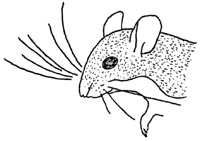

|
|
NATURE NOTES FROM ACADIA

Unless you camp out or take an occasional walk through the woods at night, you probably have not become acquainted with White-foot. Because the word "mouse" to the layman means an animal identical in form and habit with the very undesirable house mouse - a fur-bearer. foreign to our country - I hesitate to call White-foot a mouse, even though he is a member of that group. For to know White-foot is to change one's conception of those very small gnawing animals which we call "mice." About 100 species of White-footed Mice are to be found on our North American continent, and all are readily distinguished by their snow-white feet and under parts. Their eyes and ears are large, and in their habits they approximate the squirrels. Their food consists largely of seeds and grain which they frequently store away. In many sections of the United States they are by far the most abundant of the fur-bearing animals. In a report on the wild life of the Yosemite National Park area one authority makes the statement that there are more of these mice than all the other mammals combined, while the same could be said of many extensive areas in our eastern Adirondacks. In Acadia National Park our White-footed representative is a large, long-tailed, big-eared variety whose color is predominantly grayish above. Being nocturnal, these attractive mice are rarely seen although they are common throughout most of Mt. Desert Island. In captivity I have found them easy to keep. The White-footed mouse ranges from Central America to the arctic circle, and is to be found from coast to coast. Roosevelt, in his "African Game Trails," describes mice "looking like our white-footed mice" which he saw in the course of his travels, but the true White-footed or Deer Mice are known to be confined to the North American continent. They occur at sea level and below it (Death Valley) and some species go to the very summits of some of our highest western mountains. I recall when two years ago a party of which I was a member found a young White-foot at an elevation of 11,000 feet on the slopes of Mt. Dana, Yosemite's second-highest mountain. In his "Animal Life of Carlsbad Cavern," Dr. Vernon Bailey writes: "The only mammals living their entire lives, being born and reaching old age, in the dark depths of the great cavern, are the cave mice, or the Texas form of the White-footed mice, near relatives of our eastern white-footed or deer mice. How they find their way about or locate their food in the utter darkness is still a cave mystery." Being a common rodent throughout much of its range, White-foot has many enemies. Hawks and owls take great toll while weasels, minks, skunks, foxes, wild cats, badgers, and other predators feed upon it to greater or less extent. Unlike the dark stocky-bodied meadow mouse White-foot does not gnaw the bark and roots of young orchard trees while the amount of grain which it may consume is usually insignificant. Then too, being at home only in the wild, it does not enter the human habitations of our towns and cities. For these reasons its economic significance is slight. If, however, you come to know this beautiful large-eyed wild mouse its slight economic significance will disappear altogether and you too will look upon it as one of the most interesting fur-bearers of our woodlands. It is that way with all wild life - the more we know about it the more fascinating it becomes. - Temporary Park Naturalist |
| <<< Previous | > Cover < | Next >>> |
nature_notes/acad/vol2-3f.htm
09-Jan-2006